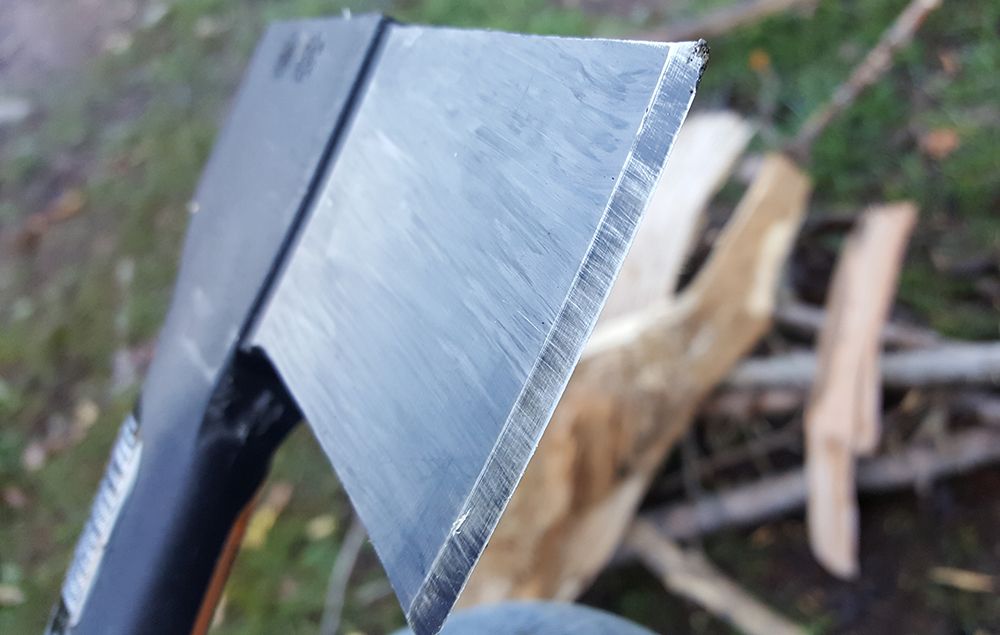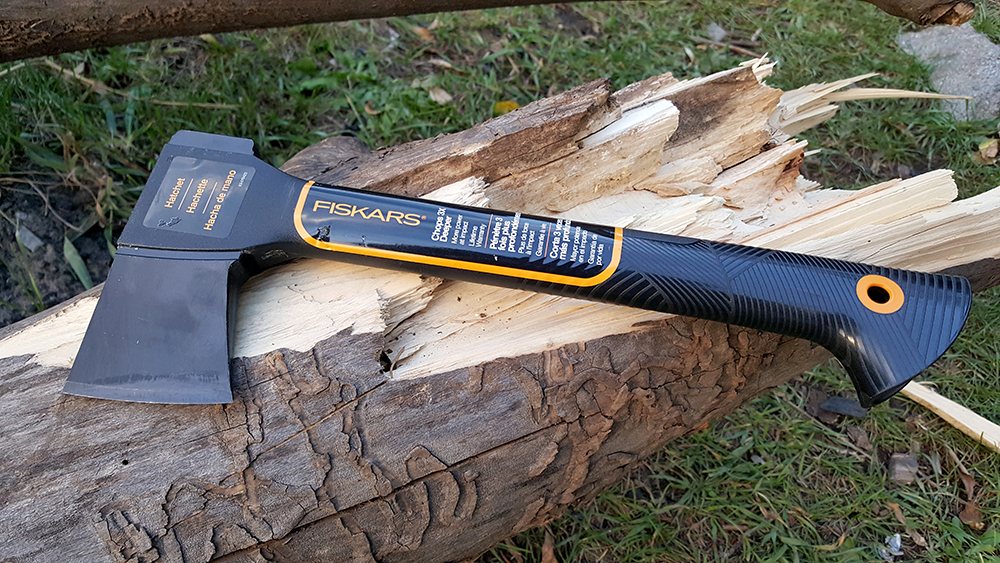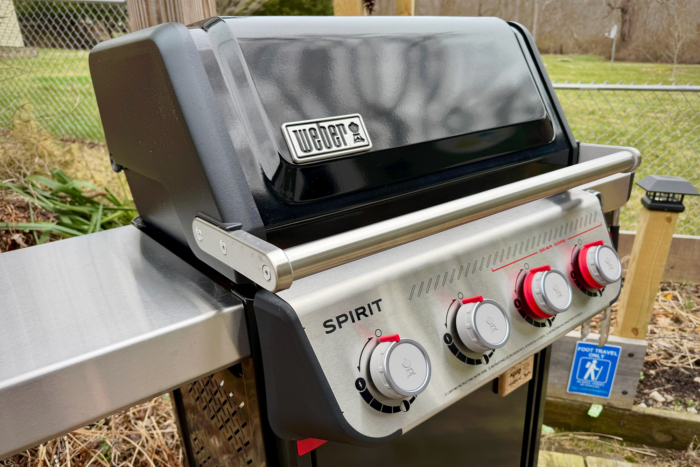While there are a million ways to camp and as many tools for the job, there is a solid case for keeping things simple with a classic camp hatchet. Lightweight, capable, and just dang fun to swing, the best camping hatchets are versatile tools for outdoor adventures, and we’ve swung the most worthy of stocking your kit.
Whether you need a tool to pound tent stakes or split wood, take a look at our list before making your decision. There are perfect all-around choppers like our top pick, the Hardcore Hammers Camp Companion, as well as cheaper options to chuck in your truck kit, like the Fiskars X7. Our experts have been whittling, chopping, and splitting for half a decade now, and have tested more than 30 different hatchets across the backwoods of the U.S.
And we’re not just talking wall hangers here, either. Every hatchet is put through our rigorous testing regiment in order to test its ability to process wood, do fine work while carving, clear trails, and be a backcountry companion. Our experts are backcountry trail crew leaders, blade-industry old hands, and just everyday outdoors folk, and we feel confident in every one of the tools below.
Editor’s Note: We updated our Camping Hatchets guide on March 11, 2025, to add three new award winners: The Council Tools Flying Fox — a hatchet that looks as good as it chops — the Bear Valley Tactical BV-TAC 8 — a tactical multitool with 7 other uses — and our new favorite overall hatchet, the Hardcore Hammers Camp Companion.
The Best Camping Hatchets of 2025
- Weight: 2 lbs., 5 oz.
- Overall Length: 16”
- Bit Length: 3.75”
- Steel Type: Black FNC coated 4140
- Handle Material: Hickory
Pros
- Balance between size and weight
- FNC coating on the head
- Hammer size
- Quality construction
Cons
- Leather sheath can be very tight at first
- Higher price than many
- Weight: 1 lb., 6 oz.
- Overall Length: 14"
- Head Length: 5"
- Steel Type: Hardened forged carbon steel
- Handle Material: FiberComp composite
Pros
- Highly affordable
- Suitable for splitting kindling or small logs
- Relatively lightweight design
- Integrated handle protects bit during transport
Cons
- Head-forward swing weight balance
- Concerns about blade chipping
- Requires more regular maintenance to keep in prime condition
- Weight: 2 lbs., 6.4 oz.
- Overall Length: 15.2"
- Head Length: 5.5"
- Steel Type: Forged & coated 1055 stainless steel
- Handle Material: Synthetic polymer with rubberized inserts
Pros
- Reliefs in head allow for easier penetration
- Advanced handle ergonomics and shock reduction
- Internal stash sleeve holds paracord and mini lighter survival tools
- Hammer poll is well sized and accurate to swing
Cons
- Much more of a splitter than a carver
- Doesn’t come well sharpened from the factory
- Fairly hefty at 2.5 pounds
- Weight: 2 lbs., 4 oz.
- Length: 15.5"
- Bit Length: 3.88"
- Steel Type: 1060 steel
- Handle Material: American hickory
Pros
- Hardened bit and poll
- Ergonomic shape for prolonged use
- Great balance
- Under $75
Cons
- Doesn’t come with a sheath as standard
- Stickers on the handle leave a lot of residue behind
- Weight: 2 lbs., 3 oz.
- Overall Length: 14.5"
- Head Length: 4.5"
- Steel Type: ⅜” 1075 carbon steel with tungsten Cerakote finish
- Handle Material: Canvas Micarta
Pros
- Single piece construction
- Cerakote finish and Micarta handle
- Massive 4.5” blade
- Advanced ergonomics
- Well balanced
Cons
- The hammer could be thicker
- Most of the knives we own are too big for the slot in the belt frog
- Weight: 2 lbs., 13 oz.
- Overall Length: 17"
- Bit Length: 4.5"
- Steel Type: S7 tool steel
- Handle Material: S7 tool steel
Pros
- S7 tool steel
- Single piece construction
- 8 tools in 1
- Paracord wrap handle
Cons
- Heavy and bulky paracord grip
- The pin that holds the sheath in place is easy to lose
- Weight: 1 lb., 5 oz.
- Overall Length: 9.4"
- Bit Length: 2.8"
- Steel Type: Hand-forged Swedish steel
- Handle Material: Hickory
Pros
- Hand-forged Swedish steel head
- Leather sheath can be used to hook the Jonaker to your belt
- Blackened finish that reduces friction and increases corrosion resistance
- Enough heft behind it to get some good chopping power
Cons
- Pricey for the size
- Smaller size will be limiting for bigger jobs
Other Hatchets We Trust in the Backcountry
- Weight: 1 lb., 7 oz.
- Overall Length: 15"
- Bit Length: 2.6"
- Steel Type: Carbon steel with low friction coating
- Handle Material: Hickory
Pros
- FiberComp overstrike protection
- Low-friction bit coating
- Balanced weight
- Palm swell on handle cradles the hand well
Cons
- The recycled leather sheath isn't the nicest
- On the pricier side for an everyday hatchet
- Weight: 2 lbs., 2 oz.
- Overall Length: 15.2"
- Bit Length: 3.3"
- Steel Type: Hand-forged Swedish steel
- Handle Material: American hickory
Pros
- Beautiful design
- Ergonomic design promotes comfort and safety when in use
- High-quality construction
- 325 years of heritage
Cons
- More expensive than other options
- Heavier than many
- Weight: 1 lb., 9 oz.
- Overall Length: 14"
- Bit Length: 3.5"
- Steel Type: Black oxide coated 3Cr13
- Handle Material: Glass-filled nylon with rubber overlay
Pros
- 0.24” thickness makes for easy cutting
- Innovative sheath with carry strap
- Swing weight is balanced across the entire hatchet
- Black oxide blade coating keeps it moving through material
Cons
- Too thin to hammer with
- 3Cr13 is a bit soft for a steel, and will need more upkeep to stay sharp
- Weight: 1 lb., 8.5 oz.
- Overall Length: 9.5"
- Head Length: 3.5"
- Steel Type: Stainless 3Cr13MoV steel
- Handle Material: Rubber/composite overmold
Pros
- Compact packed size
- Tall grind maintains sharpness
- Finger grooves for choking up on fine detail work
- Great for uses of all experience and dedication levels
Cons
- Less durable sheath
- Not meant for bigger jobs
- Weight: 2 lb., 2 oz.
- Overall Length: 15"
- Bit Length: 3.3"
- Steel type: Hand-forged Swedish steel
- Handle Material: Hickory
Pros
- Budget price with great value
- Classic design and build
- Hand-forged Swedish steel
- Good handle ergonomics
Cons
- Doesn’t come with a full sheath
- Head-heavy swing weight, which takes some getting used to
- Weight: 1 lb., 4.8 oz.
- Overall Length: 13.7"
- Head Length: 4"
- Steel Type: Recycled steel
- Handle Material: Hickory
Pros
- Blacksmith-forged head with stamped initials
- Polished cutting edge
- Quality vegetable-tanned leather sheath
- Fine carving abilities
Cons
- Price
- Simple fit and finish
- Can be more difficult to source on this side of the pond
- Weight: 1 lb., 5 oz.
- Overall Length: 13.2"
- Bit Length: 3.2"
- Steel Type: Manganese phosphate coated 1055 carbon steel
- Handle Material: Glass-reinforced nylon
Pros
- Lightweight but effective
- Forged 1055 carbon steel head for long-term abuse
- Glass-reinforced nylon handle is tough
- Broad hammer poll surface area
Cons
- Doesn’t come with a sheath
- Ideally suited for splitting kindling, not much bigger
- Weight: 1 lb., 14.4 oz.
- Overall Length: 14"
- Head Length: 4"
- Steel Type: C45 steel
- Handle Material: U.S. hickory
Pros
- Beautiful design
- Ergonomic design promotes comfort and safety when in use
- High-quality construction
- Eco-friendly manufacturing
Cons
- More expensive than other options
- Unique shape of axe head takes a bit getting used to
- Heavier than other options
- Not the best for backpacking
- Weight: 1 lb., 12 oz.
- Overall Length: 16"
- Head Length: 3"
- Steel Type: Hand-forged Swedish steel
- Handle Material: American hickory
Pros
- Functional design
- Incredibly durable
- Holds edge even after many uses
- Exceptionally sharp blade out of the box
Cons
- A bit long for a camp hatchet; not as portable
- One of the most expensive hatchets on our list
- Hand-forged steel can sometimes lead to uneven grinding

Camping Hatchet Comparison Chart
| Camping Hatchet | Price | Weight | Overall Length | Steel Type | Handle Material |
|---|---|---|---|---|---|
| Hardcore Hammers Camp Companion | $200 | 2 lbs., 5 oz. | 16″ | Black FNC coated 4140 | Hickory |
| Fiskars X7 | $35 | 1 lb., 6 oz. | 14″ | Hardened forged carbon steel | FiberComp composite |
| Gerber Bushcraft Hatchet | $70 | 2 lbs., 6.4 oz. | 15.2″ | Forged & coated 1055 stainless steel | Synthetic polymer with rubberized inserts |
| Council Tools Flying Fox Woodsman | $67 | 2 lbs., 4 oz. | 15.5″ | 1060 steel | American hickory |
| TOPS Hammer Hawk | $530 | 2 lbs., 3 oz. | 14.5″ | 1075 carbon steel with tungsten Cerakote finish | Canvas Micarta |
| Bear Valley Tactical BV-TAC 8 | $200 | 2 lbs., 13 oz. | 17″ | S7 tool steel | S7 tool steel |
| Hults Bruk Jonaker | $189 | 1 lb., 5 oz. | 9.4″ | Hand-forged Swedish steel | Hickory |
| Fiskars Norden N7 Hatchet | $120 | 1 lb., 7 oz. | 15″ | Carbon steel with low friction coating | Hickory |
| Hults Bruk 325-Year Anniversary Axe | $184 | 2 lbs., 2 oz. | 15.2″ | Hand-forged Swedish steel | American hickory |
| Kershaw Deschutes | $103 | 1 lb., 9 oz. | 14″ | Black oxide coated 3Cr13 | Glass-filled nylon with rubber overlay |
| Gerber Pack Hatchet | $45 | 1 lb., 8.5 oz. | 9.5″ | Stainless 3Cr13MoV steel | Rubber overmold |
| Husqvarna Swedish Style Hatchet | $70 | 2 lb., 2 oz. | 15″ | Hand-forged Swedish Steel | Hickory |
| Gränsfors Bruk Wildlife Hatchet | $185 | 1 lb., 4.8 oz. | 13.7″ | Recycled hand-forged Swedish steel | Hickory |
| CRKT Chogan Hatchet | $65 | 1 lb., 5 oz. | 13.1″ | 1055 carbon steel | Glass-reinforced nylon |
| Adler Rheinland Hatchet | $89 | 1 lb., 14.4 oz. | 14″ | C45 steel | American hickory |
| Hults Bruk Almike | $199 | 1 lb., 12 oz. | 16″ | Hand-forged Swedish steel | American hickory |

How We Tested the Best Camping Hatchets
Our Testing Process and Testing Locations

Balance Test

Chop Test / Edge Test
Weather Test

Our Expert Testers

Buyer’s Guide: How to Choose the Best Camping Hatchet

Hatchet Head Anatomy

- Cheek: The cheek of the hatchet head is the side profile of the head. Unless the head has splitting attributes, this will be smooth and sometimes convex.
- Butt: The back of the hatchet which you can use as a hammer. Unless specified otherwise.
- Beard: The beard of the hatchet head uses the bottom of the head in front of the handle. Depending on the shape, you can use the heel, or bottom of the bit, to roll and drag branches and logs. Additionally, the top of the bit is known as a toe.
- Eye: The eye of the hatchet is where the handle slides through the head. If the butt isn’t hardened, you run the risk of deforming the eye, which will cause the head to fall off.

Head Coatings

Head Weight and Handle Length

Ease of Splitting

Durability

Carry

Price & Value
Budget

Mid-Tier
Premium
Frequently Asked Questions
Choosing the best camping hatchet is almost entirely dependent on the individual and its intended use. Some companies certainly have a stronger reputation than others, but choosing the single best camping hatchet for everyone is a nearly impossible task.
We did our best in outlining some of our favorites above and ultimately chose the Hardcore Hammers Camp Companion Axe (traditional) and Gerber Bushcraft Hatchet (modern) as our overall favorites. That said, that doesn’t mean these two hatchets are for everyone.
Sort your priorities and intended uses, and weigh some pros and cons of various options. You will soon find that the best camping hatchet for you may not be the best hatchet for your camping partner.

While you certainly do not need a hatchet for camping, it does make our list as a top tool to have on any camping adventure. Hatchets are multifaceted tools; from instruments of survival to campground maintenance tools, hatchets can be used for many things in the woods.
We can say with almost full confidence that you will never regret having a hatchet with you when camping. Inevitably, someone will pick it up to split wood, make kindling, or tinker with a small bushcraft project around the fire. There is also something to be said about learning new skills and promoting self-sufficiency when out in the woods.
What’s more fun — having firewood delivered or using newly learned skills to gather your own?

All hatchets are axes, but not all axes are hatchets.
In short, hatchets are just small, lightweight axes. Axes can and often should be used with one hand as an all-purpose tool.
The classic grip to use a standard axe requires two hands. These axes are less utilitarian and have a more focused design for tree felling, wood chopping, and other forestry needs.
Depending on shape and construction, hatchets are good for quite a lot. Their most common purpose is for chopping and splitting smaller sections of wood. Hatchets excel at cutting green wood or chopping dead wood roughly the diameter of an average forearm and slightly bigger.
Given their smaller size, hatchets are excellent tools for more intricate bushcraft tasks. They are the perfect instrument for shelter design or carving and crafting woodworking projects. In a bind, hatchets work when cutting through bone and cartilage if you do not have a field dressing knife on you following a hunt.
For a deeper, expanded look at the possibilities a hatchet can provide, check out this article.

A good hatchet will last for generations, but it will require some upkeep. Most of the hatchets on our list are sharp straight out of the box, but some may come from the factory without an edge. Either way, every hatchet will eventually need maintenance to keep it in good, safe, working order.
The frequency with which you sharpen your hatchet will depend on how often you use it and what you are using it for. If you purchased a high-quality hatchet, only go camping once or twice a year, and use it sparingly, you may not need to sharpen it frequently.
Many hatchets come with user manuals for guidance in sharpening, or you might consult the U.S. Forest Service Ax Manual. Some hatchets even include a file and sharpening stone with your purchase. We’ve relied on this Dual Grit Sharpener for years as it’s easy to use, can restore an edge quickly, and doesn’t take up much space in your pack.
Many professionals sharpen knives and axes for a living. If you don’t have the time to give your hatchet the proper maintenance it deserves, consider taking it to someone who does.
Different manufacturers may have specific recommendations on how to store your hatchet when you’re not using it. You can always refer to the included manual or their website for specific instructions.
Beyond that, we recommend you clean up your hatchet before storing it. Any moisture and debris can impact the overall quality and reliability of your hatchet over time. Make sure to clean off the head of any debris and wipe it dry before putting it back in the sheath.
As wood handles start to age, over time they may require a rewaxing or sealing. There are a few different methods for doing this, but we recommend following the manufacturer’s instructions and using any products they offer to restore the handle to its original state.
With any piece of gear or clothing, it’s best to store it in a dry place. Hatchets are a little hardier than some of the other gear you take along with you on your adventures, but that doesn’t mean that they’re not susceptible to the elements.

The Best Bushcraft Knives of 2025
Whether splitting logs or whittling by the fire, we’ve found the best bushcraft knives for every budget and use.

The Best Tactical Knives of 2025
Known by many names, a tactical knife generally refers to a hardworking, do-all blade. Here, we review the best folding and fixed-blade knives for every budget and use.























































